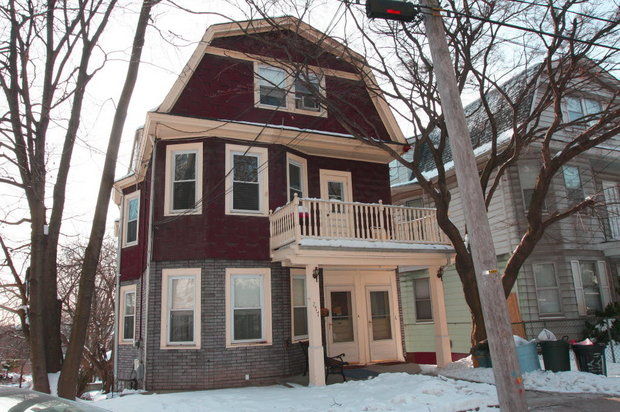February 16, 2014
Huge Increase In Number of Staten Island Homes Sold As Prices Jump, Supply Shrinks

This two-family house on St. Paul's Avenue in Stapleton was on the market for 42 days last year before it was sold to Reuben Finkle, who lives in Brooklyn and views Stapleton as a neighborhood with "so much potential." (Staten Island Advance/Jan Somma-Hammel)
By Virginia N. Sherry/Staten Island Advance
STATEN ISLAND, N.Y. -- "Someone told me to buy on Staten Island because it's an undiscovered treasure chest in New York City," said Reuben Finkle, who purchased a two-family home on St. Paul's Avenue in Stapleton last June.
Finkle, who lives in Brooklyn, was one of over 3,000 buyers who decided to invest in the borough's residential real-estate market in 2013, leading to a 29 percent jump in the number of closed sales on houses, condominiums, and cooperative apartments, compared to the previous year.
There were 2,449 closings in 2011, and another 2,525 the following year, a modest increase of 3 percent, according to statistics from the Staten Island Board of Realtors (SIBOR).
But in 2013, the number of closed sales reached 3,259 homes at year's end.
Finkle's house was on the market for only 42 days and his sale closed in June, reported New Dorp-based Sari Kingsley Real Estate.
Finkle started looking last year for a residential property on the Island, and knew it was over when he saw the St. Paul's Avenue property.
 |
| "Someone told me to buy on Staten Island because it's an undiscovered treasure chest in New York City," said Reuben Finkle. |
"It appealed to me because it was like the houses in Montreal, where I grew up," he said. "When I came to New York ten years ago, I had $20 in my pocket and drove a cab. Now I own the cab, and bought this house," added Finkle, who views Stapleton as a neighborhood with "so much potential."
'STRONGER BUYER CONFIDENCE'
"It was amazing, super -- we sold 404 homes in 2013," said Tom Crimmins, owner of the Castleton Corners realty office bearing his name, who cited several reasons for the increased closings.
"There was strong buyer confidence that the market hit bottom, the (mortgage) interest rates were great, and sellers accepted that prices will be where they are for a while," Crimmins said.
"There were a ton of first-time buyers," he continued, noting the Island's "blue-collar community, where they know they have a good job and are taking advantage of an opportunity" for a personal residence or investment.
"It was a great year," agreed Claire Bisignano Chesnoff, a member of the board of directors of SIBOR, board member of the Staten Island Chamber of Commerce, and owner of Claire Properties in New Dorp.
She believes that the increased sales activity was due, in part, to the expiration, on December 31, 2013, of federal tax-relief provided to homeowners with principal residences "underwater" -- worth less on the market than the debt owed to lenders.
The Mortgage Forgiveness Debt Relief Act, enacted in 2007, lifted the IRS tax burden for owners in such situations if they sold their homes in short sales: The forgiven debt was not counted as taxable income.
The Island MarketThe Staten Island Board of Realtors has a method for classifying residential locations, and the Advance will take a more in-depth look at each of these areas in an ongoing series of reports. These are the SIBOR categories and communities they include: Greater St. GeorgeSt. George, Tompkinsville, Stapleton, Clifton, Rosebank, Shore Acres, Fort Wadsworth, Ward Hill, Grymes Hill, Park Hill, and Concord. North ShoreNew Brighton, Snug Harbor, Livingston, Randall Manor, West Brighton, Port Richmond, Elm Park, Mariners Harbor, Graniteville, Arlington, and Bloomfield. East ShoreArrochar, Grasmere, Old Town, South Beach, Dongan Hills, Grant City, and Midland Beach. GatewayNew Dorp, Oakwood, Oakwood Beach, Oakwood Heights, Bay Terrace, Great Kills, and Eltingville. South ShoreAnnadale, Southeast Annadale, Arden Heights, Rossville, Woodrow, Huguenot, Prince's Bay, Pleasant Plains, Charleston, Richmond Valley, and Tottenville. The HillsEmerson Hill, Todt Hill, Lower Todt Hill, Lighthouse Hill, Richmond, High Rock, Dongan Hills Colony, and Emerson Valley. The LakesClove Lakes, Castleton Corners, Silver Lake, Royal Oak, Sunset Hill, Sunnyside, and Westerleigh. HeartlandWillowbrook, Manor Heights, Bulls Head, New Springville, Heartland Village, Travis, and LaTourette. |
"Boomerang buyers" -- people who lost homes to foreclosure when the housing bubble collapsed but returned to the market last year -- also contributed to increase in closing, Ms. Bisignano Chesnoff said.
The slow climb-back from the recession, and predictions that historically low mortgage interest-rates would rise, helped spur 2013 sales, added Linda Baran, president and CEO of the Staten Island Chamber of Commerce. "There were signs that that economy is upticking," she said. "We had an increase in Chamber membership in 2013 and a lot of grand openings (of new businesses on the Island)," she said.
Asked if the buzz around the New York Wheel and Empire Outlets projects in St. George was a factor in higher number of homes sold Island-wide, Ms. Baran replied: "I don't think so -- not at this point. Maybe (the development projects) affected commercial and business sales, but not residential."
FOR-SALE HOMES IN SHORTER SUPPLY
The supply of residential property on the Island decreased in 2013, with almost one-third fewer properties to look at, compared to the previous year, according to SIBOR's statistics.
 This one-family, 3-bedroom home at 65 Rockland Ave.in Egbertville was on the market for 38 days in 2013; the sale closed in August. This one-family, 3-bedroom home at 65 Rockland Ave.in Egbertville was on the market for 38 days in 2013; the sale closed in August. |
The borough-wide inventory of homes for sale stood at 2,654 last August.
It decreased steadily over the next four months, with only 1,827 residential properties for sale at the end of December, compared to 2,635 a year earlier, representing a 30.7 percent drop.
The lower inventory was part of a three-year pattern that showed property owners less ready to offer their homes to the market.
The year 2011 ended with 3,147 homes for sale across the Island. That number dropped 16 percent by the end of 2012.
As the supply of homes for sale declined, it came as no surprise that deals were struck closer and closer to original asking prices.
In 2011, sellers received 89.5 percent of the asking price, according to SIBOR. The next year, it rose to 90.9 percent, and there was a jump to 92.2 percent in 2013.
It also took less time for residential properties to sell, according to SIBOR data.
The average number of days that residential properties were on the market was 165 in 2011.That increased to 172 days in 2012, but declined to 150 days last year.
MEDIAN SALES PRICES
The median sales price of Staten Island homes rose steadily but not dramatically between 2011 and 2013, SIBOR reported.
It was $375,000 in 2011, and rose almost 3 percent in 2012, to $385,000. And the jump last year was to $392,000.
The average price showed a slightly different performance over the past three years. From $409,804 in 2011, and $419,801 in 2012, it declined a bit last year, to $417,660.
